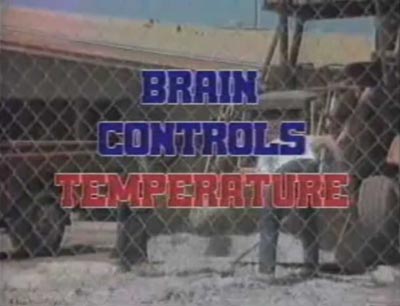ideas

The amazement that can turn out to have been the beginning of love usually leads nowhere but still alerts one to the value at which full-blown love would stand in amazement. Lucky for me, my wife sometimes strikes me afresh with wonder, as if I hadn’t already known her for forty years: she strikes me, then, as if she were a wonderful stranger. If I weren’t vulnerable to strangers, I would be lacking in vulnerability to that occasional stranger who is my wife.
Feeling incipient love for a perfect stranger thus enlivens one’s capacity for appreciating personhood in other ways. It may be followed by reflective solitude or depressing loneliness or the thought of a real-life lover, all of which are further ways of valuing personhood.
{ J. David Velleman, Sociality and Solitude | Continue reading }
ideas, relationships | May 23rd, 2011 6:23 pm

The many worlds interpretation of quantum mechanics is the idea that all possible alternate histories of the universe actually exist. At every point in time, the universe splits into a multitude of existences in which every possible outcome of each quantum process actually happens.
So in this universe you are sitting in front of your computer reading this story, in another you are reading a different story, in yet another you are about to be run over by a truck. In many, you don’t exist at all.
This implies that there are an infinite number of universes, or at least a very large number of them. (…)
The reason many physicists love the many worlds idea is that it explains away all the strange paradoxes of quantum mechanics.
For example, the paradox of Schrodinger’s cat–trapped in a box in which a quantum process may or may not have killed it– is that an observer can only tell whether the cat is alive or dead by opening the box.
But before this, the quantum process that may or may not kill it is in a superposition of states, so the cat must be in a superposition too: both alive and dead at the same time.
That’s clearly bizarre but in the many worlds interpretation, the paradox disappears: the cat dies in one universe and lives in another.
Let’s put the many world interpretation aside for a moment and look at another strange idea in modern physics. This is the idea that our universe was born along with a large, possibly infinite, number of other universes. So our cosmos is just one tiny corner of a much larger multiverse.
Today, Leonard Susskind at Stanford University in Palo Alto and Raphael Bousso at the University of California, Berkeley, put forward the idea that the multiverse and the many worlds interpretation of quantum mechanics are formally equivalent.
{ The Physics arXiv Blog | Continue reading }
photo { William Eggleston }
ideas, science | May 23rd, 2011 6:22 pm

An Amazonian tribe has no abstract concept of time, say researchers.
The Amondawa lacks the linguistic structures that relate time and space - as in our idea of, for example, “working through the night.”
The study, in Language and Cognition, shows that while the Amondawa recognize events occuring in time, it does not exist as a separate concept. (…)
“We’re really not saying these are a ‘people without time’ or ‘outside time’,” said Chris Sinha, a professor of psychology of language at the University of Portsmouth.
“Amondawa people, like any other people, can talk about events and sequences of events. What we don’t find is a notion of time as being independent of the events which are occuring; they don’t have a notion of time which is something the events occur in.”
The Amondawa language has no word for “time,” or indeed of time periods such as “month” or “year.”
The people do not refer to their ages, but rather assume different names in different stages of their lives or as they achieve different status within the community.
But perhaps most surprising is the team’s suggestion that there is no “mapping” between concepts of time passage and movement through space.
Ideas such as an event having “passed” or being “well ahead” of another are familiar from many languages, forming the basis of what is known as the “mapping hypothesis.” But in Amondawa, no such constructs exist.
{ BBC | Continue reading }
Linguistics, time | May 23rd, 2011 6:01 pm

The intentional torts of trespass against land and chattels, and the underlying property interests which they protect, are surely a foundation of any legal system that supports the private production of goods and services. The prevalence of these causes of action against theft—technically, involuntary transfers—even prior to the earliest development of common law legal systems supports this intuition.
But the trespass tort and its related causes of action presuppose a common set of normative expectations that identifies the set of goods to which the underling theft prohibition applies. If there were no widely obeyed norm against trespass of land and conversion of property, it would be exceedingly costly to enforce the formal laws against it, or in the absence of supplemental state enforcement, to undertake self-help measures to do so. That consensus may appear to be well-settled with respect to real property (my house) and most forms of tangible property (my car). That normative consensus tracks a positive consensus. Despite periodic intellectual fashions to the contrary, empirical evidence is clear that secure property rights are a critical ingredient in economic growth. (…)
However, any such consensus is often unsettled with respect to intangible goods—ideas and the various technologies and forms of expression in which those ideas are embodied—and, especially, to the set of creative goods protected by copyright. There are more than a handful of serious commentators who refuse to extend, or decline to presumptively extend, the empirically-grounded logic behind property rights in land and tangible assets to property rights in ideas, forms of expression and other intangible assets.
{ Jonathan M. Barnett, What’s So Bad About Stealing? | SSRN | Continue reading }
photo { Doug DuBois }
ideas, law, photogs | May 20th, 2011 10:38 pm

Quantification — describing reality with numbers — is a trend that seems only to be accelerating. From digital technology to business and financial models, we interact with the world by means of quantification.
While we all interact with the world through more-or-less inflexible models, mathematics contributes to this lack of flexibility because it is seemingly precise and objective. Even though mathematical models can be very complex, you can use them without understanding them very well. A trader need not really understand the financial engineering models that he may use on daily basis. This uncritical acceptance amounts to the assumption that reality is identical to our rational reconstruction of reality — for example, that the economy or the stock market is captured by our latest model. (…)
Statistical models are all based on the notion of randomness, but no one can really understand randomness. Many people use the word random without realizing that random means what it says — randomness cannot be predicted or controlled. A model of randomness is no longer true randomness.
Because they are logically consistent, mathematical models screen out ambiguity. Ambiguity is real, but business and financial models have little to no room for it.
{ Harvard Business Review | Continue reading }
economics, ideas, mathematics | May 20th, 2011 10:26 pm

A thing is called finite after its kind, when it can be limited by another thing of the same nature ; for instance, a body is called finite because we always conceive another greater body. So, also, a thought is limited by another thought, but a body is not limited by thought, nor a thought by body.
{ Spinoza, The Ethics, published posthumously in 1677 | Continue reading }
photo { Louis Porter }
photogs, spinoza | May 20th, 2011 11:05 am

One group of Australian researchers have managed to teach robots to do something that, until now, was the reserve of humans and a few other animals: they’ve taught them how to invent and use spoken language. The robots, called LingoDroids, are introduced to each other. In order to share information, they need to communicate. Since they don’t share a common language, they do the next best thing: they make one up. The LingoDroids invent words to describe areas on their maps, speak the word aloud to the other robot, and then find a way to connect the word and the place, the same way a human would point to themselves and speak their name to someone who doesn’t speak their language.”
{ Slashdot | Continue reading }
artwork { Thomas Schütte, United Enemies, 1994-95 | fimo, fabric, wood glass and PVC }
Linguistics, robots & ai | May 18th, 2011 3:00 pm

Science knows approximately how, and when, our Earth will end. In about five billion years the sun will run out of hydrogen, which will upset its self-regulating equilibrium; in its death-throes it will swell, and this planet will vaporize. Before that, we can expect, at unpredictable intervals measured in tens of millions of years, bombardment by dangerously large meteors or comets. Any one of these impacts could be catastrophic enough to destroy all life, as the one that killed the dinosaurs 65 million years ago nearly did. In the nearer future, it is pretty likely that human life will become extinct – the fate of almost all species that have ever lived.
{ Richard Dawkins/Washington Post | Continue reading }
artwork { Dan Holdsworth, Blackout 08, 2010 }
related:

eschatology, haha | May 18th, 2011 3:00 pm

One of the things I asked him was is a computer going to create Beethoven’s 10th Symphony? What is the role for creativity? I think Robin and others would say: Well, we romanticize that. It’s still just neurons firing. A great chess player we think of as an artistic genius, but a great computer has now surpassed almost all of the great chess players. Just again a matter of romance and time before we eliminate this idea that there is something more than the brain.
I have a number of comments. One is that when we say, to take the particular example we always use, that computers play great chess, first of all I would claim there are actually two games there. There’s computer chess and human chess, and it isn’t exactly the same game. Humans play chess very differently than computers. In a certain sense you are comparing apples with oranges when you claim that. You want to stop and explain that? What happens is computers, because they have such a large memory capacity, and they do very simple operations so quickly, they can go through literally millions of possibilities in a very short amount of time. Human beings cannot do that, so they have to rely on other capacities they have that the computer doesn’t have, things like intuition, judgment, and feel. Things which are difficult to quantify. In fact, human beings have all these capacities which are essentially non-quantifiable: That is to say, we have parts of our brains that operate non-digitally.
{ William Byers/EconTalk | Continue reading }
photo { Jean-Michel Basquiat photographed by Andy Warhol, 1984 }
ideas | May 16th, 2011 6:05 pm

Burundanga is a scary drug. (…) The scale of the problem in Latin America is not known, but a recent survey of emergency hospital admissions in Bogotá, Colombia, found that around 70 per cent of patients drugged with burundanga had also been robbed, and around three per cent sexually assaulted. “The most common symptoms are confusion and amnesia,” says Juliana Gomez, a Colombian psychiatrist. (…)
News reports allude to another, more sinister, effect: that the drug removes free will, effectively turning victims into suggestible human puppets. Although not fully understood by neuroscience, free will is seen as a highly complex neurological ability and one of the most cherished of human characteristics.
{ Wired UK | Continue reading }
Neuroscientists
increasingly describe our behaviour as the result of a chain of
cause-and-effect, in which one physical brain state or pattern of
neural activity inexorably leads to the next, culminating in a
particular action or decision. With little space for free choice in
this chain of causation, the conscious, deliberating self seems to
be a fiction. From this perspective, all the real action is
occurring at the level of synapses and neurotransmitters.
For now most of us are content to believe that we have control over
our own lives, but what would happen if we lost our faith in free
will?
{ Susan Sayler | Continue reading }
oil on canvas { Aron Wiesenfeld, The Wedding Party }
controversy, ideas, neurosciences | May 16th, 2011 5:30 pm

Dr Bryan Caplan, an academic and economist from George Mason University in Virginia, believes parents are working far too hard at bringing up their children. (…)
“Quit fretting over how much TV your kids watch. Don’t force them to do a million activities they hate. Accept that your children’s lives are shaped mostly by their genes and their own choices, not by the sacrifices you make in hopes of turning them into successful adults.”
Caplan points to scientific evidence to support the idea of “serenity parenting.” Research on twins and on adopted children shows, he says, that parents’ long-term effects range from small to zero for a wide range of outcomes such as health and success. (…)
Research also shows that a child’s intelligence can be increased by parental interaction when they are very young, but by the time the child reaches 12 the effect has disappeared.
{ Guardian | Continue reading | More: Bryan Caplan on Parenting | EconTalk | Audio + Transcript }
controversy, kids | May 16th, 2011 4:25 pm

Restaurants are held to a higher standards of food preparation than individuals. Few rules constrain your holiday meal for twenty, but if you served ten folks for lunch in a tiny diner, a huge rule book applies.
In Europe, firms are also held to a higher privacy standards than individuals. Firms must be careful to store your emails to them very carefully, to ensure a very low risk they might be stolen. But individuals can be very sloppy in how they store emails.
There are many such apparent regulatory “biases,” i.e., ways that regulations hold some things to higher standards than others, even when the relevant consequences seem similar. For example we seem to prefer: Individuals over firms, Human over machine control, Non- over for-profit organizations…
{ Overcoming Bias | Continue reading }
artwork { Eric Thor Sandberg }
ideas | May 12th, 2011 6:59 pm

At first glance, a diagram of the complex network of genes that regulate cellular metabolism might seem hopelessly complex, and efforts to control such a system futile.
However, an MIT researcher has come up with a new computational model that can analyze any type of complex network — biological, social or electronic — and reveal the critical points that can be used to control the entire system.
Potential applications of this work, which appears as the cover story in the May 12 issue of Nature, include reprogramming adult cells and identifying new drug targets.
{ MIT News | Continue reading }
artwork { Mark Lombardi, World Finance Corporation and Associates, ca. 1970-84 }
ideas, science | May 12th, 2011 6:57 pm

Ideas have retained some of the properties of organisms. Like them, they tend to perpetuate their structure and to breed; they too can fuse, recombine, segregate their content; indeed they too can evolve, and in this evolution selection must surely play an important role. (…)
Ideas cause ideas and help evolve new ideas. They interact with each other and with other mental forces in the same brain, in neighboring brains, and thanks to global communication, in far distant, foreign brains. And they also interact with the external surroundings to produce in toto a burstwise advance in evolution that is far beyond anything to hit the evolutionary scene yet.
{ Jacques Monod/Smithsonian Magazine | Continue reading }
screenshot { Charlie Kaufman’s Synecdoche, New York, 2008 }
ideas, technology | May 12th, 2011 3:11 pm

The fact that we’re living in a nightmare that everyone is making excuses for and having to find ways to sugarcoat. And the fact that life, at its best, is a pretty horrible proposition. But people’s behavior makes it much, much worse than it has to be.
{ Woody Allen | Continue reading }
In my business you’re only as good as your last move, like an actor in his last movie. Just because I got one thing right four years ago doesn’t mean I get everything right now. The most important thing is to be right… your reputation depends on being right day by day.
{ Nouriel Roubini | Continue reading }
image { A Delaunay triangulation in the plane with circumcircles shown }
experience, ideas, woody allen | May 10th, 2011 3:26 pm

Asshole: A man displaying an egocentric disregard for the opinions, needs, and feelings of those around him. He is rude, obnoxious, and self-centered. He thinks he’s a straight-talker who speaks the hard truths that PC wusses aren’t ready for. His bravado typically masks some deep insecurities. It is well documented that women go for assholes. (…)
Douchebag: A dick move may make you a temporary asshole, but a pattern of bad behavior can land you with the unfortunate label of douchebag. (…) Assholes can skate by on charisma, but douchebags rely on belligerence, bullying, and sheer volume to get their way.
{ The Good Men Project| Continue reading }
Linguistics | May 7th, 2011 10:00 am

Psychologists have shown that people have a very, very strong, robust confirmation bias. What this means is that when they have an idea, and they start to reason about that idea, they are going to mostly find arguments for their own idea. They’re going to come up with reasons why they’re right, they’re going to come up with justifications for their decisions. They’re not going to challenge themselves.
And the problem with the confirmation bias is that it leads people to make very bad decisions and to arrive at crazy beliefs. And it’s weird, when you think of it, that humans should be endowed with a confirmation bias. If the goal of reasoning were to help us arrive at better beliefs and make better decisions, then there should be no bias. The confirmation bias should really not exist at all. (…)
In Western thought, for at least the last couple hundred years, people have thought that reasoning was purely for individual reasons. But Dan challenged this idea and said that it was a purely social phenomenon and that the goal was argumentative, the goal was to convince others and to be careful when others try to convince us. (…)
The idea here is that the confirmation bias is not a flaw of reasoning, it’s actually a feature. It is something that is built into reasoning; not because reasoning is flawed or because people are stupid, but because actually people are very good at reasoning — but they’re very good at reasoning for arguing.
{ Edge | Continue reading }
photo { Christy Turlington and Linda Evangelista photographed by Patrick Demarchelier, Vogue UK, 1990 }
ideas | May 5th, 2011 1:45 pm
art, ideas, michel foucault | May 4th, 2011 9:06 am

In contrast to the widespread idea that some people have good lives and others bad, I think that while some lives are better than others, no lives are good enough to count as (non-comparatively) good. (…)
Whatever view one might have about what makes a life good or bad, human lives fall short on the good things but abound in the bad. (…)
Consider pleasures and pains. Most lives contain both, to varying degrees, but there is an unfortunate asymmetry between these that seems to apply to even the best of lives. The upshot of this is that there is much more pain than pleasure. (…)
People tend to forget how much of their lives are spent tired, hungry, thirsty, in pain and being either too hot or too cold or in need of voiding their bladders and bowels. The same is true of how much time people spend bored, stressed, anxious, fearful, frustrated, irritated, sad, and lonely, to name but a few examples. Also unnoticed is how bad the worst parts of a life are. They often, but not always, come later in life, but the life as a whole cannot be evaluated without considering them. Moreover, we spend a very short period of time in our prime. Most of a person’s life, for those who live to old age, is spent in steady decline.
{ The Philosophers’ Magazine | Continue reading }
photo { Alex Prager }
ideas | May 2nd, 2011 6:59 pm

There are (at least) two ways to implement a (Star Trek style) transporter:
1. A space-time wormhole takes you “directly” from here to there, or
2. We scan you, send the info, make a new copy at the other end, and destroy the original.
Some people care greatly about transporter type; they’d pay to use type #1, but pay greatly to avoid using type #2. But regardless of the morality of a type #2 transporter, I’m pretty confident that if cheap type #2 transporters were available, but not type #1, many people would use them often. (…)
A similar relation applies to two types of super-watches. (…) Here are the two ways to make super-watches:
1. Time Machine + Memory Wipe: The second time you push the button you enter a time machine that brings you back to soon after the moment you first pushed the button, displaced by a few feet. It also erases all memories you might have acquired since the first time you pushed the button. And no, you can’t bring anything else with you in the time machine.
2. Limited Time Copier: When you turn on the watch it makes an exact copy of you and puts that copy a few feet away. When you turn the watch off, or it automatically turns off, you are destroyed.
{ Overcoming Bias | Continue reading }
ideas, time | May 2nd, 2011 6:57 pm
























